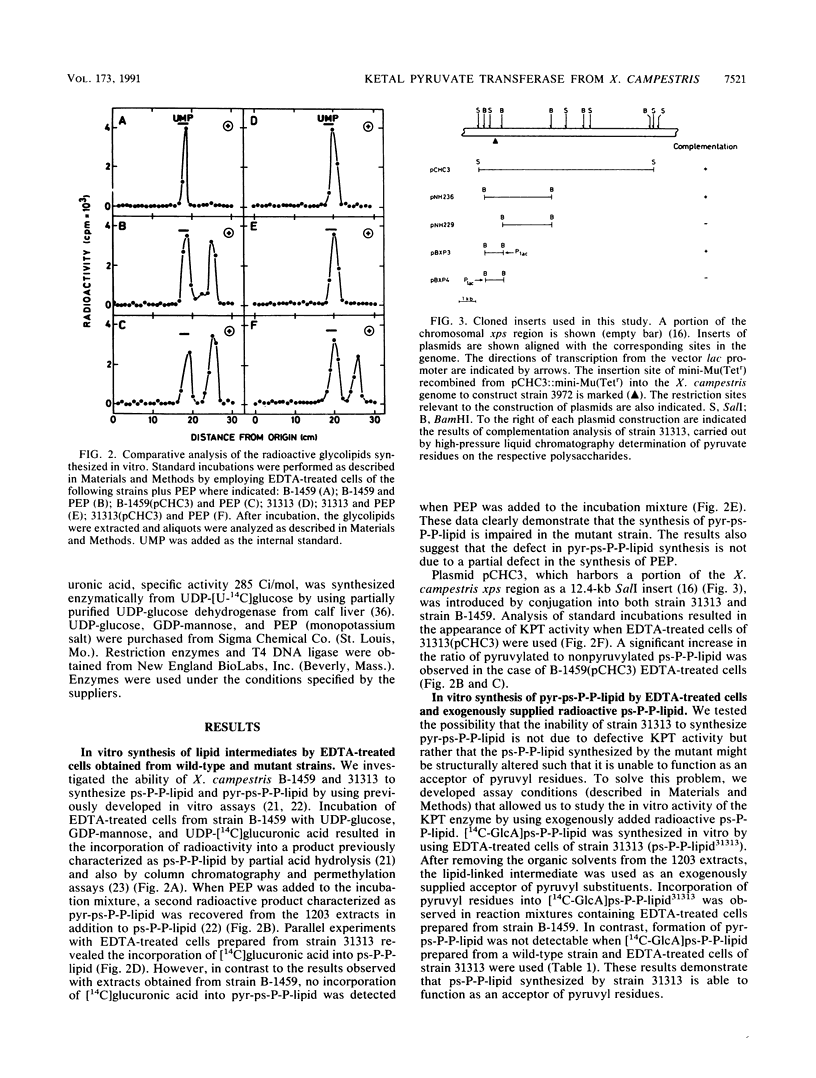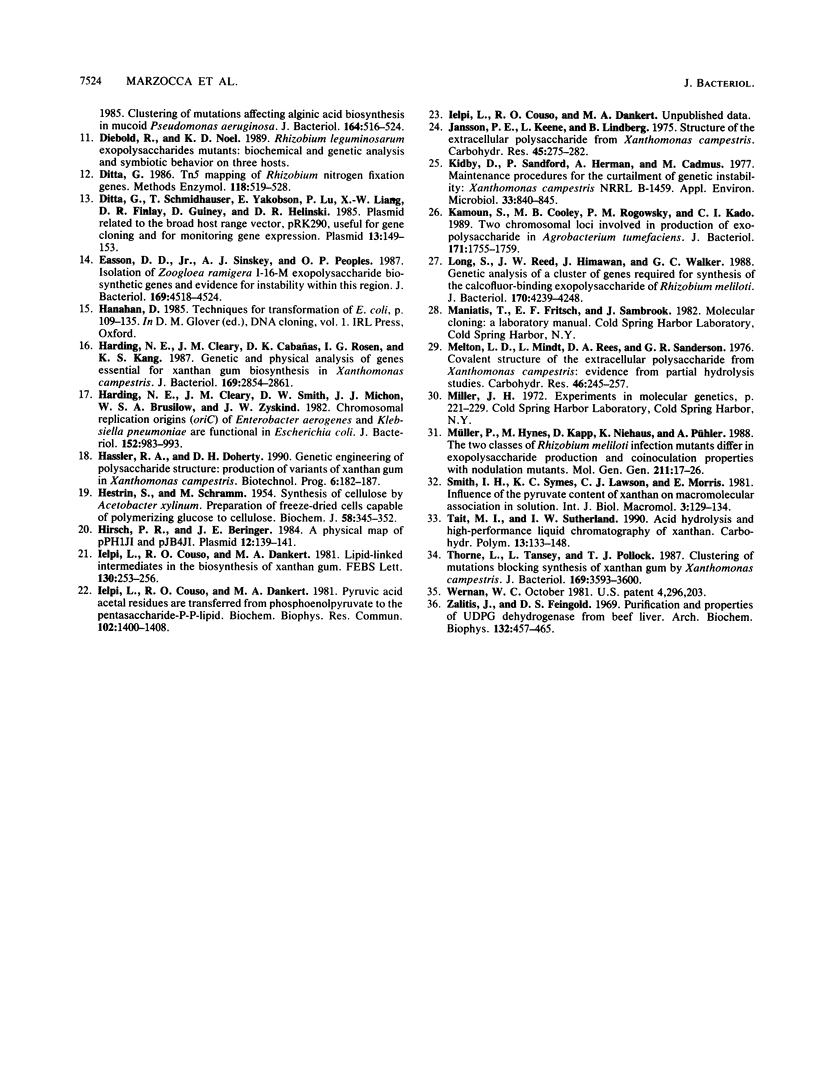Abstract
Genes required for xanthan polysaccharide synthesis (xps) are clustered in a DNA region of 13.5 kb in the chromosome of Xanthomonas campestris. Plasmid pCHC3 containing a 12.4-kb insert of xps genes has been suggested to include a gene involved in the pyruvylation of xanthan gum (N.E. Harding, J.M. Cleary, D.K. Cabañas, I. G. Rosen, and K. S. Kang, J. Bacteriol. 169:2854-2861, 1987). An essential step toward understanding the biosynthesis of xanthan gum and to enable genetic manipulation of xanthan structure is the determination of the biochemical function encoded by the xps genes. On the basis of biochemical characterization of an X. campestris mutant which produces pyruvate-free xanthan gum, complementation studies, and heterologous expression, we have identified the gene coding for the ketal pyruvate transferase (kpt) enzyme. This gene was located on a 1.4-kb BamHI fragment of pCHC3 and cloned in the broad-host-range cloning vector pRK404. An X. campestris kpt mutant was constructed by mini-Mu(Tetr) mutagenesis of the cloned gene and then by recombination of the mutation into the chromosome of the wild-type strain.
Full text
PDF





Selected References
These references are in PubMed. This may not be the complete list of references from this article.
- Baldwin T. O., Berends T., Bunch T. A., Holzman T. F., Rausch S. K., Shamansky L., Treat M. L., Ziegler M. M. Cloning of the luciferase structural genes from Vibrio harveyi and expression of bioluminescence in Escherichia coli. Biochemistry. 1984 Jul 31;23(16):3663–3667. doi: 10.1021/bi00311a014. [DOI] [PubMed] [Google Scholar]
- Belas R., Mileham A., Simon M., Silverman M. Transposon mutagenesis of marine Vibrio spp. J Bacteriol. 1984 Jun;158(3):890–896. doi: 10.1128/jb.158.3.890-896.1984. [DOI] [PMC free article] [PubMed] [Google Scholar]
- Birnboim H. C., Doly J. A rapid alkaline extraction procedure for screening recombinant plasmid DNA. Nucleic Acids Res. 1979 Nov 24;7(6):1513–1523. doi: 10.1093/nar/7.6.1513. [DOI] [PMC free article] [PubMed] [Google Scholar]
- Cangelosi G. A., Hung L., Puvanesarajah V., Stacey G., Ozga D. A., Leigh J. A., Nester E. W. Common loci for Agrobacterium tumefaciens and Rhizobium meliloti exopolysaccharide synthesis and their roles in plant interactions. J Bacteriol. 1987 May;169(5):2086–2091. doi: 10.1128/jb.169.5.2086-2091.1987. [DOI] [PMC free article] [PubMed] [Google Scholar]
- Couso R. O., Ielpi L., Garcia R. C., Dankert M. A. Biosynthesis of polysaccharides in Acetobacter xylinum. Sequential synthesis of a heptasaccharide diphosphate prenol. Eur J Biochem. 1982 Apr;123(3):617–627. doi: 10.1111/j.1432-1033.1982.tb06577.x. [DOI] [PubMed] [Google Scholar]
- Ditta G., Schmidhauser T., Yakobson E., Lu P., Liang X. W., Finlay D. R., Guiney D., Helinski D. R. Plasmids related to the broad host range vector, pRK290, useful for gene cloning and for monitoring gene expression. Plasmid. 1985 Mar;13(2):149–153. doi: 10.1016/0147-619x(85)90068-x. [DOI] [PubMed] [Google Scholar]
- Easson D. D., Jr, Sinskey A. J., Peoples O. P. Isolation of Zoogloea ramigera I-16-M exopolysaccharide biosynthetic genes and evidence for instability within this region. J Bacteriol. 1987 Oct;169(10):4518–4524. doi: 10.1128/jb.169.10.4518-4524.1987. [DOI] [PMC free article] [PubMed] [Google Scholar]
- HESTRIN S., SCHRAMM M. Synthesis of cellulose by Acetobacter xylinum. II. Preparation of freeze-dried cells capable of polymerizing glucose to cellulose. Biochem J. 1954 Oct;58(2):345–352. doi: 10.1042/bj0580345. [DOI] [PMC free article] [PubMed] [Google Scholar]
- Harding N. E., Cleary J. M., Cabañas D. K., Rosen I. G., Kang K. S. Genetic and physical analyses of a cluster of genes essential for xanthan gum biosynthesis in Xanthomonas campestris. J Bacteriol. 1987 Jun;169(6):2854–2861. doi: 10.1128/jb.169.6.2854-2861.1987. [DOI] [PMC free article] [PubMed] [Google Scholar]
- Harding N. E., Cleary J. M., Smith D. W., Michon J. J., Brusilow W. S., Zyskind J. W. Chromosomal replication origins (oriC) of Enterobacter aerogenes and Klebsiella pneumoniae are functional in Escherichia coli. J Bacteriol. 1982 Dec;152(3):983–993. doi: 10.1128/jb.152.3.983-993.1982. [DOI] [PMC free article] [PubMed] [Google Scholar]
- Hassler R. A., Doherty D. H. Genetic engineering of polysaccharide structure: production of variants of xanthan gum in Xanthomonas campestris. Biotechnol Prog. 1990 May-Jun;6(3):182–187. doi: 10.1021/bp00003a003. [DOI] [PubMed] [Google Scholar]
- Hirsch P. R., Beringer J. E. A physical map of pPH1JI and pJB4JI. Plasmid. 1984 Sep;12(2):139–141. doi: 10.1016/0147-619x(84)90059-3. [DOI] [PubMed] [Google Scholar]
- Ielpi L., Couso R. O., Dankert M. A. Pyruvic acid acetal residues are transferred from phosphoenolpyruvate to the pentasaccharide-P-P-lipid. Biochem Biophys Res Commun. 1981 Oct 30;102(4):1400–1408. doi: 10.1016/s0006-291x(81)80167-2. [DOI] [PubMed] [Google Scholar]
- Ielpi L., Couso R., Dankert M. Lipid-linked intermediates in the biosynthesis of xanthan gum. FEBS Lett. 1981 Aug 3;130(2):253–256. doi: 10.1016/0014-5793(81)81132-5. [DOI] [PubMed] [Google Scholar]
- Jansson P. E., Kenne L., Lindberg B. Structure of extracellular polysaccharide from Xanthomonas campestris. Carbohydr Res. 1975 Dec;45:275–282. doi: 10.1016/s0008-6215(00)85885-1. [DOI] [PubMed] [Google Scholar]
- Kamoun S., Cooley M. B., Rogowsky P. M., Kado C. I. Two chromosomal loci involved in production of exopolysaccharide in Agrobacterium tumefaciens. J Bacteriol. 1989 Mar;171(3):1755–1759. doi: 10.1128/jb.171.3.1755-1759.1989. [DOI] [PMC free article] [PubMed] [Google Scholar]
- Kidby D., Sandford P., Herman A., Cadmus M. Maintenance procedures for the curtailment of genetic instability: Xanthomonas campestris NRRL B-1459. Appl Environ Microbiol. 1977 Apr;33(4):840–845. doi: 10.1128/aem.33.4.840-845.1977. [DOI] [PMC free article] [PubMed] [Google Scholar]
- Long S., Reed J. W., Himawan J., Walker G. C. Genetic analysis of a cluster of genes required for synthesis of the calcofluor-binding exopolysaccharide of Rhizobium meliloti. J Bacteriol. 1988 Sep;170(9):4239–4248. doi: 10.1128/jb.170.9.4239-4248.1988. [DOI] [PMC free article] [PubMed] [Google Scholar]
- Melton L. D., Mindt L., Rees D. A., Sanderson G. R. Covalent structure of the extracellular polysaccharide from Xanthomonas campestris: evidence from partial hydrolysis studies. Carbohydr Res. 1976 Feb;46(2):245–257. doi: 10.1016/s0008-6215(00)84296-2. [DOI] [PubMed] [Google Scholar]
- Thorne L., Tansey L., Pollock T. J. Clustering of mutations blocking synthesis of xanthan gum by Xanthomonas campestris. J Bacteriol. 1987 Aug;169(8):3593–3600. doi: 10.1128/jb.169.8.3593-3600.1987. [DOI] [PMC free article] [PubMed] [Google Scholar]
- Zalitis J., Feingold D. S. Purification and properties of UDPG dehydrogenase from beef liver. Arch Biochem Biophys. 1969 Jul;132(2):457–465. doi: 10.1016/0003-9861(69)90389-0. [DOI] [PubMed] [Google Scholar]


